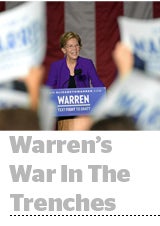 Initially, it seemed fair to wonder whether Elizabeth Warren’s campaign could survive a long, grueling primary.
Initially, it seemed fair to wonder whether Elizabeth Warren’s campaign could survive a long, grueling primary.
The Warren campaign raised $6 million in the first quarter of the year, fifth most in the field, according to campaign disclosures released earlier this year. But it spent almost as much building up the operation, with 160 people on payroll by April, almost double the size of Bernie Sanders’ campaign despite raising a third as much.
Salary commitments can cripple a campaign, soaking up money needed for advertising and events. But Warren’s campaign put people on the ground in early primary states.
It wasn’t just a wager that her campaign would last – Warren’s team is betting on canvassing and organization to drive data and media more effectively than if the campaign plowed money back into Facebook and email fundraising.
And their bet seems to have paid off. In Q2, the Massachusetts Senator raised $19.1 million, edging out the Sanders campaign to set the new high bar for Democratic candidates.
The Warren campaign model only seems risky however, because it is new for candidates, said one ad tech and data executive who worked with the campaign.
“By this time next year it’s going to be clear that the Warren campaign is a model for how national races are run,” the exec said.
Media knowledge
The Warren campaign’s heavy upfront investments in employee salaries are meant to pay dividends in 2020, when the real primaries and ad dollars get moving.
“Right now, our biggest expense as a campaign is our staff, but as the campaign heats up, it will be on media to reach potential voters,” campaign manager Roger Lau wrote in a note to supporters last week. “We have built an in-house staff to produce videos and ads rather than adopt the consultant-driven approach of other campaigns (and the big commissions and fees that come along with it).”
One of Warren’s first hires was Joe Rospars, the campaign’s chief strategist and CEO of Blue State (formerly Blue State Digital), a liberal digital media agency owned by WPP. The campaign uses Blue State for analytics and to manage its site, but doesn’t pay for high-margin services like production and media buying.
Eric Reif, the campaign’s paid media director, is the former media director of liberal digital media agency Bully Pulpit Interactive, and helped develop the in-house media-buying operation. The Warren campaign disclosed almost $1 million in ad spend with BPI from the first few months of the year, which sources said was reimbursed by the campaign after it accidentally bought Facebook ads on BPI’s account.
BPI’s help in standing up the Warren camp’s in-house operation and Rospars’ hybrid role as chief strategist and CEO of a digital agency show how a new generation of data and media pros are working with candidates.
Organizing data
But digital and data experts have reshaped Warren’s campaign beyond just advertising. For instance, the campaign doesn’t have a pollster, which would have been unimaginable only a few years ago.
“We’re seeing campaigns rethink their data from the ground up,” said one Blue State executive, who also pointed to Beto O’Rourke’s campaign as an example where digital media and data replaced old-fashioned polling.
With experts from vendors like Blue State and BPI, the Warren team does its own audience modeling and data collection, saving potentially hundreds of thousands of dollars in consultant fees and third-party data purchases. And without pollster data, the team relies on digital advertising data and information gotten directly from voters.
The investments in state operations and canvassing flow back to the data team as well.
As voter registration teams or door-to-door canvassers collect names, they freshen up social and email audience lists, which can go stale quickly in politics because of the constant fundraising requests.
The Warren campaign uses Hustle, a peer-to-peer texting service, and Reach, a canvassing app born out of Alexandria Ocasio-Cortez’s successful House race in 2018, sources said. Those tech vendors connect names collected by in-state teams and canvassers to the central Democratic database, creating audience segments based on issues or candidates people previously supported.
Data from data-driven canvassing solution or even RTB data is a better way for campaigns to keep their finger on the pulse of voter sentiment than polling because it can be used in real time, said one Warren campaign vendor exec.
Donor demand
Warren’s donations spike when the candidate announces policy news, often coordinated with what’s hot on social media, where most of the fundraising occurs, according to a Blue State exec on her fundraising team. The campaign saw a big jump from its average daily haul in late May, when the campaign released a reproductive rights plan on the same day that the last abortion clinic in the state of Missouri was shuttered.
Campaign donations spiked again in June when Warren visited Homestead detention center, where immigrant children have been imprisoned, and released a new immigration policy.
Candidates can go out and buy 130,000 donors on Facebook, the Warren tech exec said, referring to the baseline requirement to qualify for the Democratic debate stage earlier this month. (And many campaigns did exactly that).
But building a larger campaign org and allocating a lower percent of overall spend to media is the more sustainable model, they said, at least until the primaries heat up and campaigns start their get out the vote drives. A savvy digital media and data team will “tell you to spend more on people and ideas instead right now.”













